In precision agriculture, you'll detect plant stress through visual cues and advanced technologies. Look for changes in leaf color, wilting, or unusual growth patterns as early signs. Thermal imaging reveals temperature variations, while multispectral and hyperspectral analyses assess plant health across different wavelengths. Chlorophyll fluorescence techniques offer insights into photosynthetic efficiency. Drones equipped with sensors can monitor soil moisture and identify pests or diseases. Nutrient deficiencies are spotted through precision nutrient management tools. By tracking crop growth stages and using these methods, you'll catch stress signals early, allowing for timely interventions. Dive deeper to master these essential stress detection strategies.
Visual Indicators of Plant Stress

Many visual cues can alert farmers to plant stress in precision agriculture.
You'll want to look for changes in leaf color, such as yellowing or browning, which often indicate nutrient deficiencies or disease. Wilting leaves are a clear sign of water stress, while curling or cupping leaves may suggest heat stress or pest infestations.
Keep an eye out for stunted growth or irregular plant shapes, as these can signal various environmental stressors.
You should also watch for premature leaf drop or flower shedding, which can indicate severe stress. Discoloration or lesions on stems and leaves are often signs of fungal or bacterial infections.
In some cases, you'll notice changes in fruit or vegetable appearance, such as blemishes, unusual shapes, or reduced size.
These visual indicators can help you quickly identify problem areas in your fields.
Thermal Imaging for Stress Detection

While visual cues are valuable, advanced technologies like thermal imaging can detect plant stress before it's visible to the naked eye. Thermal cameras measure the temperature of plant surfaces, revealing stress-induced changes in transpiration rates. You'll find that stressed plants often have higher leaf temperatures due to reduced water content and stomatal closure.
Thermal imaging allows you to:
- Detect water stress early
- Identify disease outbreaks
- Assess nutrient deficiencies
- Monitor overall crop health
Here's a quick comparison of thermal imaging applications:
| Stress Type | Temperature Change | Detection Time |
|---|---|---|
| Water Stress | Increase | 1-2 days |
| Disease | Variable | 3-5 days |
| Nutrient | Slight Increase | 1-2 weeks |
You can use thermal imaging data to create stress maps of your fields, enabling targeted interventions. By integrating this technology with other precision agriculture tools, you'll optimize resource allocation and improve crop management decisions. Remember, early detection through thermal imaging can greatly reduce yield losses and improve overall farm productivity.
Multispectral Analysis in Agriculture

Multispectral analysis takes precision agriculture to the next level by capturing data across multiple wavelengths of light. This technique allows you to see beyond what's visible to the human eye, revealing essential information about plant health and stress.
You'll typically use specialized cameras that can detect light in the visible, near-infrared, and short-wave infrared spectrums. These cameras create detailed images that highlight variations in plant vigor, chlorophyll content, and water stress. By analyzing the reflectance patterns in different spectral bands, you can identify early signs of nutrient deficiencies, pest infestations, or disease outbreaks.
One of the most valuable aspects of multispectral analysis is its ability to generate vegetation indices like NDVI (Normalized Difference Vegetation Index). These indices provide quantitative measures of plant health and can be used to create prescription maps for targeted interventions.
You can integrate multispectral data with other precision agriculture tools, such as soil sensors and weather stations, to get a thorough view of your field's condition. This integration enables you to make more informed decisions about irrigation, fertilization, and pest management, ultimately leading to improved crop yields and resource efficiency.
Hyperspectral Sensors and Crop Health

You'll find hyperspectral sensors revolutionizing crop health monitoring through detailed spectral signature analysis.
These advanced tools enable you to detect plant stress earlier than ever before, often before visible symptoms appear.
Spectral Signature Analysis
Spectral signature analysis is a powerful tool in precision agriculture for evaluating crop health. It allows you to detect plant stress before visible symptoms appear, giving you a significant advantage in managing your crops. By analyzing the light reflected from plants across various wavelengths, you can identify specific stress indicators.
Here's what you need to know about spectral signature analysis:
- It utilizes hyperspectral sensors to capture detailed reflectance data
- Different plant conditions have unique spectral signatures
- Stress can be detected in the visible, near-infrared, and shortwave infrared regions
- Chlorophyll content, water stress, and nutrient deficiencies can be identified
- Machine learning algorithms help interpret complex spectral data
You'll find that spectral signature analysis offers early detection of crop issues, enabling you to take timely action.
It's particularly useful for large-scale farming operations where visual inspection isn't feasible. By integrating this technology into your precision agriculture practices, you'll be able to optimize resource allocation, reduce crop losses, and improve overall yield.
Early Stress Detection
With the advent of hyperspectral sensors, early stress detection in crops has become more precise and efficient than ever before. You'll find these sensors can capture detailed spectral information across a wide range of wavelengths, allowing for the identification of subtle changes in plant physiology that indicate stress.
You can use hyperspectral imaging to detect stress indicators before they're visible to the naked eye. This technology enables you to identify issues like nutrient deficiencies, water stress, pest infestations, and diseases at their earliest stages. By analyzing the unique spectral signatures of plants, you'll be able to pinpoint specific stressors and take targeted action.
When you implement early stress detection systems, you're giving yourself a considerable advantage in precision agriculture. You'll be able to optimize resource allocation, reduce crop losses, and improve overall yield quality.
Precision Nutrient Management
Hyperspectral sensors don't just excel at early stress detection; they're also game-changers for precision nutrient management. These advanced tools allow you to monitor your crops' nutrient status in real-time, enabling targeted interventions that maximize yield while minimizing resource waste.
By analyzing the light reflected from your crops, hyperspectral sensors can reveal:
- Nitrogen deficiencies
- Phosphorus imbalances
- Potassium shortages
- Micronutrient issues
- Overall plant health status
This detailed information empowers you to make data-driven decisions about fertilizer application. You'll know exactly which nutrients your crops need, where they're needed, and in what quantities.
This precision approach not only boosts crop productivity but also reduces environmental impact by preventing over-fertilization.
You can integrate hyperspectral data with other precision agriculture tools, like GPS-guided applicators, to create highly accurate nutrient maps.
These maps guide variable-rate fertilizer applications, ensuring each part of your field receives the ideal nutrient mix. By tailoring your nutrient management strategy to your crops' specific needs, you'll improve plant health, increase yield potential, and enhance your farm's overall efficiency and sustainability.
Chlorophyll Fluorescence Measurement Techniques
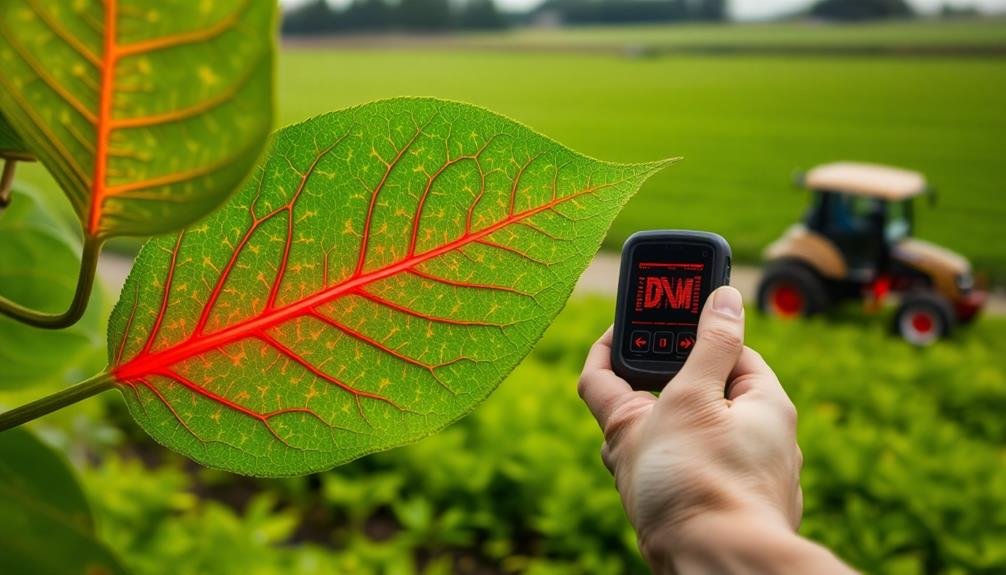
Chlorophyll fluorescence measurement techniques have revolutionized the way we assess plant stress in precision agriculture. These methods allow you to detect stress before visible symptoms appear, giving you a vital advantage in managing your crops.
You'll find several techniques at your disposal, each with its own strengths:
| Technique | Advantages | Applications |
|---|---|---|
| Pulse-Amplitude Modulation (PAM) | High sensitivity, non-destructive | Field and laboratory use |
| Imaging Fluorescence | Spatial resolution, early detection | Large-scale monitoring |
| Laser-Induced Fluorescence (LIF) | Remote sensing capability | Aerial surveys |
| Fluorescence Lifetime Imaging | Detailed photosynthetic analysis | Research and advanced diagnostics |
When using these techniques, you're measuring the light re-emitted by chlorophyll molecules after excitation. This fluorescence provides valuable information about the plant's photosynthetic efficiency and overall health. By analyzing changes in fluorescence parameters, you can identify various stressors such as drought, nutrient deficiencies, or disease.
To implement chlorophyll fluorescence measurements effectively, you'll need to calibrate your equipment, establish baseline readings for healthy plants, and interpret results in the context of environmental conditions and growth stages. With practice, you'll gain insights that can greatly improve your crop management decisions.
Soil Moisture Monitoring via Drones
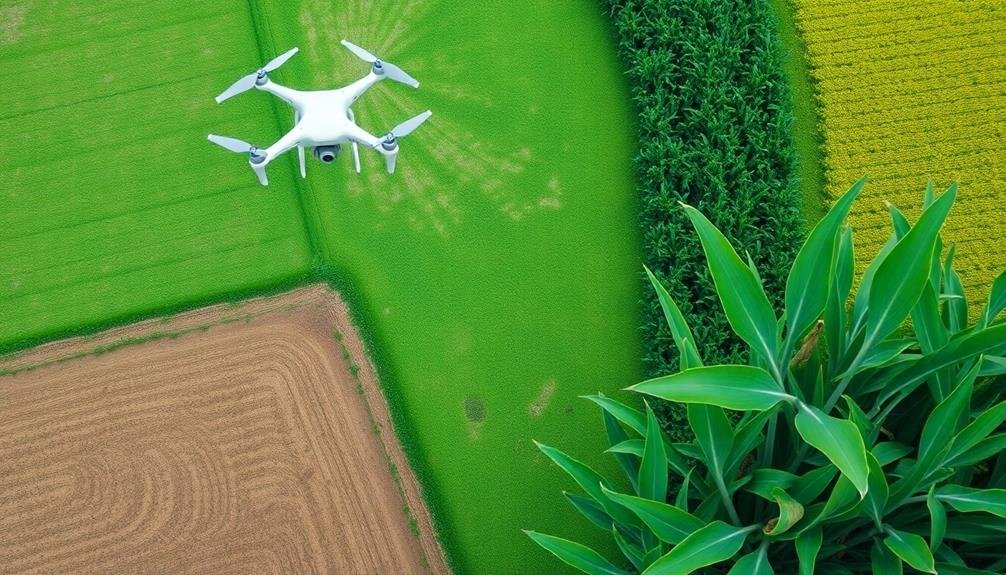
Drones have emerged as a game-changing tool for soil moisture monitoring in precision agriculture. They offer a quick and efficient way to assess large areas of farmland, providing valuable insights into plant stress caused by water deficiency.
You'll find that drone-based soil moisture monitoring systems typically use multispectral or thermal imaging sensors to capture data.
These systems work by:
- Detecting variations in soil surface temperature
- Analyzing plant canopy reflectance
- Measuring thermal emissivity of the soil
- Utilizing specialized soil moisture indices
- Integrating data with ground-based sensors
You can use this technology to create detailed soil moisture maps, helping you identify areas that need irrigation or are at risk of water stress.
By combining drone data with other precision agriculture techniques, you'll be able to make more informed decisions about water management. This approach not only improves crop yields but also conserves water resources.
Remember, early detection of soil moisture issues is essential for preventing plant stress and maintaining ideal growing conditions.
With drone-based monitoring, you're equipped to respond quickly to changing soil conditions and guarantee your crops receive the right amount of water at the right time.
Pest and Disease Identification
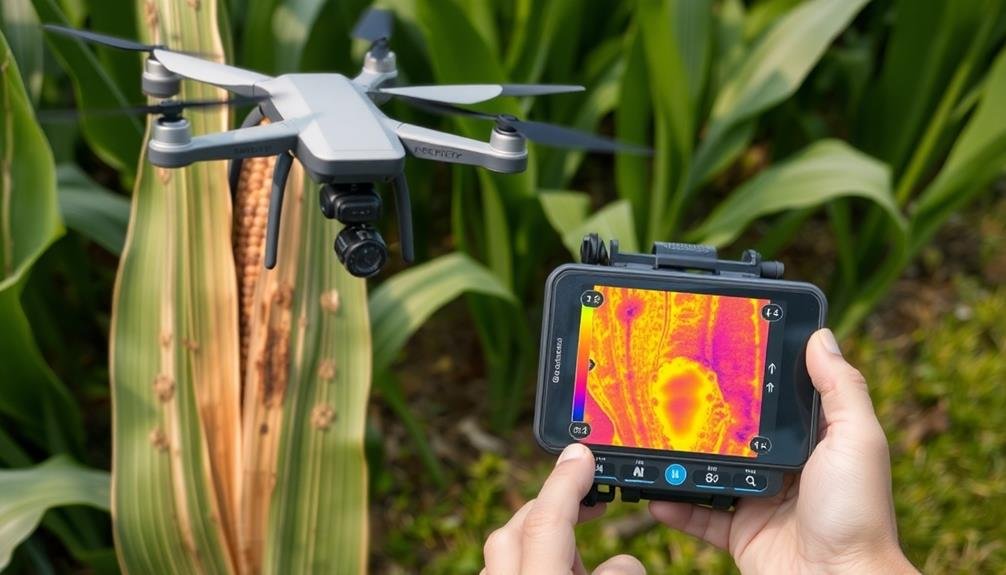
You'll find that identifying pests and diseases is essential in precision agriculture.
Visual pest indicators and disease symptom detection allow you to spot problems early, enabling timely interventions.
With automated pathogen recognition systems, you can quickly analyze plant images to identify specific threats, streamlining the pest management process.
Visual Pest Indicators
Visual pest indicators often serve as the first line of defense in identifying plant stress caused by pests and diseases. You'll need to develop a keen eye for spotting these signs, as early detection can make a significant difference in managing crop health.
When inspecting your plants, look for:
- Discoloration or spots on leaves
- Holes or chewed edges on foliage
- Wilting or drooping of stems and leaves
- Unusual growth patterns or deformities
- Presence of insects or their eggs
You'll find that these visual cues can provide valuable insights into the type of pest or disease affecting your crops. For instance, yellowing leaves might indicate nutrient deficiencies or viral infections, while curled leaves could suggest aphid infestations.
Regularly monitoring your fields will help you become familiar with the normal appearance of your plants, making it easier to spot abnormalities.
Disease Symptom Detection
Accurate disease symptom detection is essential for effective pest and disease management in precision agriculture. You'll need to be vigilant and observant to catch early signs of plant diseases. Look for discoloration, spots, or lesions on leaves, stems, and fruits. Wilting, stunted growth, and leaf distortion can also indicate disease presence.
You should familiarize yourself with common disease symptoms specific to your crops. For example, powdery mildew appears as white, powdery spots on leaves, while bacterial blight causes water-soaked lesions.
Use high-resolution cameras and spectral imaging to detect symptoms that aren't visible to the naked eye. These technologies can identify subtle changes in plant tissue before symptoms become apparent.
Don't forget to monitor environmental conditions that favor disease development. High humidity, prolonged leaf wetness, and temperature fluctuations can increase disease risk.
Regularly inspect your crops, paying close attention to areas prone to poor air circulation or excessive moisture. By combining visual observations with advanced imaging techniques and environmental data, you'll be better equipped to detect and manage plant diseases in your precision agriculture operation.
Automated Pathogen Recognition
Automated pathogen recognition systems are revolutionizing pest and disease identification in precision agriculture. These systems use advanced imaging technologies and machine learning algorithms to detect and classify plant pathogens quickly and accurately.
You'll find that they can identify a wide range of diseases and pests, often before visible symptoms appear.
To implement automated pathogen recognition in your precision agriculture practices, consider the following:
- Invest in high-resolution cameras and sensors
- Choose software with robust machine learning capabilities
- Integrate the system with your existing farm management tools
- Train your staff to use and interpret the results effectively
- Regularly update the system's database to include new pathogens
Nutrient Deficiency Detection Methods
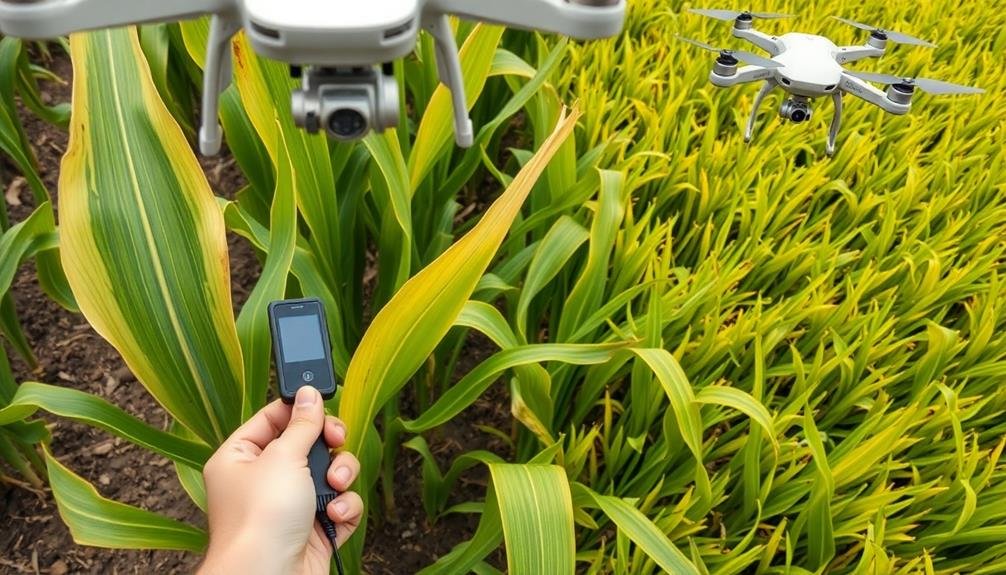
Precision agriculture's toolkit for identifying nutrient deficiencies has expanded considerably in recent years. You'll find that modern farmers now have access to a range of sophisticated methods to detect and address plant nutritional issues before they become severe.
One of the most common techniques you'll encounter is spectral imaging. Using specialized cameras mounted on drones or satellites, you can capture images that reveal subtle changes in plant coloration and structure indicative of specific nutrient deficiencies.
You'll also see the use of handheld chlorophyll meters, which measure leaf greenness to assess nitrogen levels quickly and non-destructively.
In-field sensors are another tool you'll come across. These devices can monitor soil moisture, pH, and nutrient levels in real-time, allowing you to make immediate adjustments to your fertilization strategy.
You might also employ leaf tissue analysis, where you'll send samples to a lab for detailed nutrient content evaluation.
For a more thorough approach, you can utilize machine learning algorithms that integrate data from multiple sources, including weather patterns, soil maps, and historical yield data, to predict and identify nutrient deficiencies with high accuracy.
Crop Growth Stage Assessment
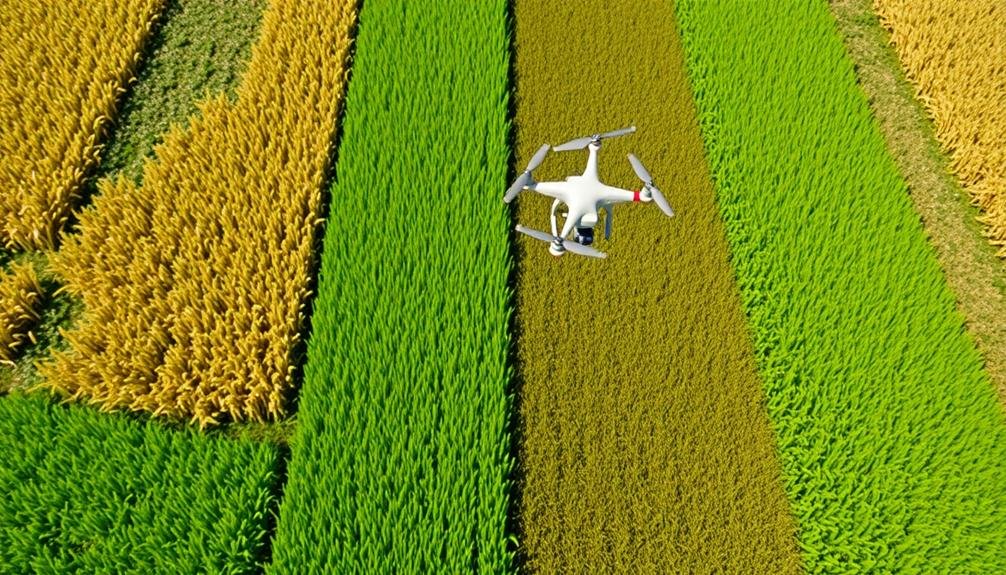
The ability to pinpoint a crop's exact growth stage is vital for optimizing management practices in precision agriculture.
You'll need to assess crop growth stages accurately to make informed decisions about irrigation, fertilization, and pest control. Modern technology offers several tools to help you monitor crop development throughout the growing season.
To effectively assess crop growth stages, you can use:
- Remote sensing technologies like satellite imagery and drones
- Ground-based sensors that measure plant height and canopy density
- Spectral analysis to detect changes in leaf color and structure
- Thermal imaging to monitor crop water stress
- Phenology models that predict growth stages based on environmental data
You'll find that combining these methods provides a thorough view of your crop's development.
By tracking growth stages, you can time your interventions more precisely, reducing waste and maximizing yield potential.
Remember, different crops have unique growth patterns, so it's important to tailor your assessment approach to the specific plants you're cultivating.
With accurate growth stage information, you'll be better equipped to address plant stress and optimize your precision agriculture practices.
Frequently Asked Questions
How Does Climate Change Impact the Effectiveness of Plant Stress Detection Methods?
Climate change alters plant stress patterns, making traditional detection methods less reliable. You'll need to adapt your techniques, as shifting temperatures and weather extremes can mask or exaggerate stress signals, requiring more frequent monitoring and advanced sensors.
What Are the Cost Implications of Implementing Precision Agriculture Stress Detection Technologies?
You'll face initial costs for sensors, drones, and software when implementing stress detection technologies. However, you'll likely see long-term savings through reduced water usage, optimized fertilizer application, and improved crop yields. It's an investment in efficiency.
Can Plant Stress Detection Techniques Be Applied to Indoor or Vertical Farming?
Yes, you can apply plant stress detection techniques to indoor and vertical farming. You'll use sensors, imaging systems, and data analytics to monitor environmental factors, nutrient levels, and plant health. This helps you optimize growing conditions and increase yields.
How Do Genetic Modifications in Crops Affect Stress Signaling and Detection?
You'll find that genetic modifications can alter a crop's stress response and signaling pathways. These changes may enhance or suppress certain stress indicators, potentially affecting how you detect and interpret stress signals in modified plants.
What Role Does Artificial Intelligence Play in Interpreting Plant Stress Signals?
You'll find AI plays an essential role in interpreting plant stress signals. It analyzes data from sensors and images, detecting subtle changes in color, temperature, and growth patterns. AI's rapid processing enables timely interventions to mitigate crop stress.
In Summary
You've explored a range of advanced techniques to detect plant stress in precision agriculture. From visual cues to high-tech sensors, you're now equipped to spot issues early. Remember, it's not just about one method; combining these approaches will give you the most thorough view of crop health. By leveraging these tools, you'll be able to intervene quickly, optimize resources, and ultimately boost your yields. Keep refining your detection methods for better agricultural outcomes.

As educators and advocates for responsible drone use, we’re committed to sharing our knowledge and expertise with aspiring aerial photographers.
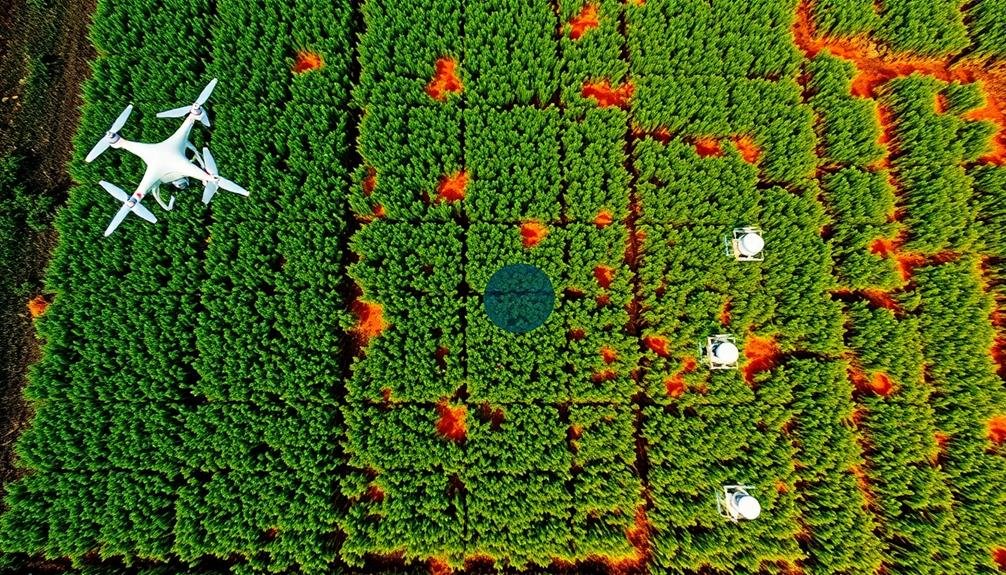



Leave a Reply